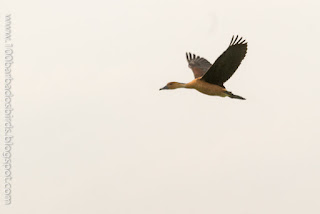 |
| Great Egret - Ardea alba |
The weather caused some damage to houses, vehicles, agricultural production and even fell trees thankfully no loss of life was reported.
Birding was not bad
I tallied sixty-six species six of which were first for the year. Here are some of my highlights other than
first for the year:
 |
| Fulvous Whistling-Duck Dendrocygna bicolor |
- Ducks made their presence felt: While Blue-winged Teal, which are normally the first migrating ducks seen for the fall migration season, were being seen from as early as September, November had two new first fall arrivals, Ring-necked Duck Aythya collaris on the 15th, Lesser Scaup Aythya affinis on the 28th. A notable mention and my second sighting of this species for the year was a beautiful Fulvous Whistling-Duck Dendrocygna bicolor seen on the 28th. Other birders have reported sightings of Ring-necked Ducks at a few locations across the island.
 |
| Gray Heron Ardea cinerea |
- Gray Heron Ardea cinerea: This large heron was seen on 5th.
 |
| Northern Waterthrush Parkesia noveboracensis |
- The return of the Northern Waterthrush Parkesia noveboracensis: I heard this warbler at one other location in the east of the island before having my first sighting at the WSR on the 25th.
 |
| Barbados x Lesser Antillean Bullfinch |
- Suspected Barbados x Lesser Antillean Bullfinch: This is the second Bird of this type I have seen, first one being in 2013 which turned out to be a hybrid, so we can assume that this one is also a hybrid. This bird was seen on the very last day of November.
The future will judge if the rains of
November 2016 broke the near two year drought on the island. The fact is that every wet area on the island
had its thirst quenched and drank to the expansion of their banks. This probably guarantees wetland habitats until
the next rainy season, which is good for the birds and birding.
Enjoy your birding I am 😉!
Here
is a list of the birds seen in November:
1.
Black-bellied Whistling
2.
Fulvous Whistling-Duck
3.
Blue-winged Teal
4.
Ring-necked Duck
5.
Lesser Scaup -
6.
Magnificent Frigatebird
7.
Brown Booby -
8.
Great Blue Heron
9.
Gray Heron
10.
Great Egret
11.
Little Egret
12.
Snowy Egret
13.
Little Blue Heron
14.
Cattle Egret
15.
Green Heron
16.
Black-crowned Night-Heron
17.
Glossy Ibis
18.
Osprey
19.
Common Gallinule
20.
Black-bellied Plover
21.
American Golden-Plover
22.
Semipalmated Plover
23.
Killdeer
24.
Whimbrel
25.
Hudsonian Godwit
26.
Ruddy Turnstone
27.
Red Knot
28.
Ruff
29.
Stilt Sandpiper
30.
Sanderling
31.
Least Sandpiper
32.
White-rumped Sandpiper
33.
Pectoral Sandpiper
34.
Semipalmated Sandpiper
35.
Short-billed Dowitcher
36.
Wilson's Snipe
37.
Spotted Sandpiper
38.
Solitary Sandpiper
39.
Greater Yellowlegs
40.
Lesser Yellowlegs
41.
Wood Sandpiper
42.
Laughing Gull
43.
Lesser Black-backed Gull
44.
Roseate Tern
45.
Royal Tern
46.
Scaly-naped Pigeon
47.
Eurasian Collared-Dove
48.
Common Ground-Dove
49.
Zenaida Dove
50.
Green-throated Carib
51.
Antillean Crested Hummingbird
52.
Belted Kingfisher
53.
Merlin
54.
Peregrine Falcon
55.
Caribbean Elaenia
56.
Gray Kingbird
57.
Black-whiskered Vireo
58.
Barn Swallow
59.
Northern Waterthrush
60.
Yellow Warbler
61.
Grassland Yellow-Finch
62.
Bananaquit
63.
Black-faced Grassquit
64.
Barbados Bullfinch
65.
Carib Grackle
66.
Shiny Cowbird
No comments:
Post a Comment